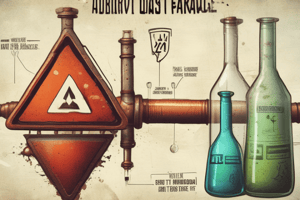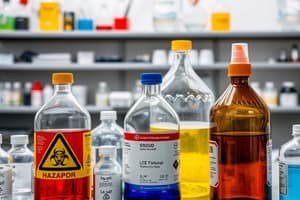Podcast
Questions and Answers
Why are emetics contraindicated in cases of corrosive ingestion?
Why are emetics contraindicated in cases of corrosive ingestion?
- They reduce the effectiveness of activated charcoal.
- They induce a false sense of safety.
- They enhance the absorption of the corrosive agent.
- They cause re-exposure to corrosives, leading to further injury. (correct)
What effect does neutralization have in cases of corrosive ingestion?
What effect does neutralization have in cases of corrosive ingestion?
- It decreases the acidity of the corrosive agent.
- It improves endoscopic visualization.
- It generates heat, worsening thermal injury. (correct)
- It facilitates faster recovery from chemical burns.
What symptoms might indicate corrosive injury in a patient?
What symptoms might indicate corrosive injury in a patient?
- Vision changes and headaches.
- Drooling and difficulty swallowing. (correct)
- High fever and rash.
- Increased appetite and fatigue.
What are the potential complications of using cathartics in a child with corrosive ingestion?
What are the potential complications of using cathartics in a child with corrosive ingestion?
What would be the priority treatment approach for a child with second-degree burns in the oropharynx?
What would be the priority treatment approach for a child with second-degree burns in the oropharynx?
What is the primary definition of a corrosive substance?
What is the primary definition of a corrosive substance?
Which of the following categories does not belong to the types of corrosives?
Which of the following categories does not belong to the types of corrosives?
What factor does not influence the severity of corrosive effects?
What factor does not influence the severity of corrosive effects?
What type of necrosis is primarily associated with acid ingestion?
What type of necrosis is primarily associated with acid ingestion?
Which mechanism of toxicity involves the hydrolysis of amide bonds?
Which mechanism of toxicity involves the hydrolysis of amide bonds?
What is a characteristic outcome of liquefactive necrosis?
What is a characteristic outcome of liquefactive necrosis?
Which part of the body is most affected during acid ingestion?
Which part of the body is most affected during acid ingestion?
What type of necrosis is characterized by the formation of a coagulum in dead tissues?
What type of necrosis is characterized by the formation of a coagulum in dead tissues?
What is the main type of necrosis caused by alkali ingestion?
What is the main type of necrosis caused by alkali ingestion?
Which symptom is NOT associated with corrosive ingestion?
Which symptom is NOT associated with corrosive ingestion?
What procedure is indicated for the management of esophageal stricture caused by alkali?
What procedure is indicated for the management of esophageal stricture caused by alkali?
What is the recommended management for pain relief in patients with corrosive toxicity?
What is the recommended management for pain relief in patients with corrosive toxicity?
Which of the following is a potential complication of alkali ingestion?
Which of the following is a potential complication of alkali ingestion?
What is the primary goal of using TPN (Total Parenteral Nutrition) in patients with corrosive injury?
What is the primary goal of using TPN (Total Parenteral Nutrition) in patients with corrosive injury?
Which of the following management strategies should be avoided in corrosive toxicity?
Which of the following management strategies should be avoided in corrosive toxicity?
What role do corticosteroids play in managing corrosive toxicity?
What role do corticosteroids play in managing corrosive toxicity?
Flashcards
Corrosive
Corrosive
A substance that causes damage and destruction to surfaces like metals and living tissues, including skin, eyes, digestive system, and respiratory tract.
Acid
Acid
A corrosive that typically donates hydrogen ions (H+).
Alkali
Alkali
A corrosive that typically accepts hydrogen ions (H+).
Oxidizer
Oxidizer
Signup and view all the flashcards
Severity of corrosive
Severity of corrosive
Signup and view all the flashcards
Caustic
Caustic
Signup and view all the flashcards
Necrosis
Necrosis
Signup and view all the flashcards
Coagulative necrosis
Coagulative necrosis
Signup and view all the flashcards
Gastric Lavage
Gastric Lavage
Signup and view all the flashcards
Steroid Use in Corrosive Ingestion
Steroid Use in Corrosive Ingestion
Signup and view all the flashcards
Mechanism of Toxicity of Sodium Hydroxide
Mechanism of Toxicity of Sodium Hydroxide
Signup and view all the flashcards
Role of Antibiotics in Corrosive Ingestion
Role of Antibiotics in Corrosive Ingestion
Signup and view all the flashcards
Why Alkalis are more damaging to the esophagus than Acids?
Why Alkalis are more damaging to the esophagus than Acids?
Signup and view all the flashcards
What is liquefactive necrosis?
What is liquefactive necrosis?
Signup and view all the flashcards
How can alkali ingestion lead to thrombus formation?
How can alkali ingestion lead to thrombus formation?
Signup and view all the flashcards
Why is the squamous epithelium of the esophagus vulnerable to alkali damage?
Why is the squamous epithelium of the esophagus vulnerable to alkali damage?
Signup and view all the flashcards
What are the common signs and symptoms of corrosive ingestion?
What are the common signs and symptoms of corrosive ingestion?
Signup and view all the flashcards
How is Corrosive ingestion managed?
How is Corrosive ingestion managed?
Signup and view all the flashcards
What is Bougienage and why is it used?
What is Bougienage and why is it used?
Signup and view all the flashcards
Why should Gastric lavage not be performed after corrosive ingestion?
Why should Gastric lavage not be performed after corrosive ingestion?
Signup and view all the flashcards
Study Notes
Toxicity of Corrosive Substances
- Corrosive substances damage, destroy, and erode surfaces like metals or living tissues (skin, eyes, etc.).
- Corrosive substances are categorized by their pH: acids (pH < 7), alkalis (pH > 7), and oxidizing agents.
- Examples of strong acids include sulfuric, hydrochloric, nitric, phosphoric, and oxalic acids.
- Examples of strong alkalis include sodium hydroxide, potassium hydroxide, ammonia, sodium carbonate, and calcium oxide.
- Oxidizing agents, such as hydrogen peroxide, bleach, and potassium permanganate, can also be corrosive.
Mechanism of Toxicity
- The effect of corrosives on living tissues is known as caustic.
- Strong acids cause protein denaturation through amide bond hydrolysis.
- Strong alkalis cause lipid saponification through ester bond hydrolysis.
- The outcome of the corrosive substances' reaction might result in the formation of coagulative necrosis (acid) or liquefactive necrosis (alkali) in the tissues.
Types of Necrosis
- Coagulative necrosis: The tissue architecture remains maintained, with the formation of gelatinous substances.
- Liquefactive necrosis: Tissue architecture is lost via the formation of a viscous liquid mass.
Severity of Corrosive Substances
- The severity depends on the concentration and volume of the ingested corrosive, the duration of contact with the tissues, and the percentage of body surface area exposed.
- Low concentrations can cause irritation; high concentrations can cause chemical burns.
Management of Corrosive Toxicity
- Treatment focuses on supportive care, with the goal of limiting further damage.
- Management for corrosive acid frequently involves use of analgesics, diluents and demulcents, antiemetic drugs, and TPN, antibiotics, systemic corticosteroids. Then, considering gastric resection in case of severe injury.
- Management for corrosive alkali often entails analgesics, diluents and demulcents, antiemetic drugs, and TPN. In severe cases, antibiotics, systemic corticosteroids, and bougienage are used, and rarely gastric resection is needed.
Important Considerations
- Gastric lavage and emesis are contraindicated as these can worsen tissue damage and lead to further exposure to corrosive substances.
- Activated charcoal is also contraindicated due to its potential to obscure endoscopic visualization. Also, neutralization is not advisable as it causes additional thermal injuries and heat.
- Cathartics are harmful as they can damage the colon, rectum, and anus.
Case Study (Example)
- A three-year-old ingested Clinitest tablets.
- Symptoms included drooling, difficulty swallowing, vomiting, and red/white spots on the mouth.
- Examination revealed second-degree esophageal burns.
- Endoscopy confirmed esophageal ulceration.
Questions Raised from Case Study
- Should gastric lavage be performed?
- Should steroids be used?
- What's the mechanism of the corrosive substance toxicity?
- Does antibiotic use play a role in treating corrosive cases?
Studying That Suits You
Use AI to generate personalized quizzes and flashcards to suit your learning preferences.




